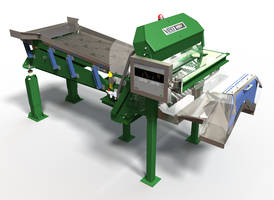Key Technology Showcases Veoâ„¢ Sorters for Seed Corn Ears at Seed Expo 2017

September 14, 2017 - Key Technology will showcase their popular Veo™ family of seed corn ear sorters at Seed Expo 2017. Downstream of the husker, Veo automatically removes ears with remaining husks, as well as defective ears and trash like stones and other foreign material (FM), from the product stream. The user defines the exact amount of husk coverage desired and can decide to pass or remove rogue ears, immature ears, bare or partially bare cobs, diseased kernels and ears with mold, stalks, shanks and nubbins to maximize product quality and improve efficiencies while reducing labor.
“By automating inspection, Veo sorters reduce manual labor in the husk room by 75 percent or more to address the challenges of low labor availability and high labor costs. Compared to manual inspection, Veo identifies more subtle visual characteristics and maintains better consistency over time, achieving a sorting efficiency of up to 98 percent. This strong value proposition has driven widespread adoption,” said Marco Azzaretti, Advanced Inspection Systems Product Manager at Key Technology. “With Veo, Key has more sorters installed in the seed corn industry than any other supplier.”
The family of Veo sorters inspects from 1500 to 4500 ears of corn per minute to meet the needs of every seed corn ear processor operating any husker type of any size. Veo 16, 12 and 8 models are designed to install immediately after the husker, each handling the throughput of 16-, 12- and 8-lane huskers, respectively. The Veo Max model offers the possibility of alternative line configurations where the output of multiple huskers is consolidated and fed to one high-capacity sorter. Every Veo sorter can be equipped for single-sided or double-sided inspection of the corn ears, and can perform either two-way or three-way sorting. Veo sorters are also available in an optional washdown construction.
Veo sorters feature top-mounted sensors for single-sided viewing or top- and bottom-mounted sensors for two-sided viewing and maximum detection performance. All are available as two-way or three-way inspection systems. With three separate discharge streams, seed corn processors can dedicate one reject stream to removing unhusked ears, which are routed back to the husker, while the second reject stream is dedicated to waste product and FM, leaving the accept stream to receive only good ears ready to go on to further processing. Two-way Veo sorters can easily and economically be upgraded in the field to the three-way configuration.
Key’s proprietary sensors, coupled with intelligent software, recognize color, shape, size and texture to detect and remove ears with husk remaining, even when the husk is of similar color as the kernels. Veo can sort any size and variety of seed corn ear, including yellow corn on red cob, yellow corn on white cob and white corn on white cob. It detects multiple mold colors.
Veo sorting systems feature an integrated Iso-Flo® vibratory infeed designed specifically for seed corn ears. Leveraging Key’s extensive product handling expertise, the infeed is a critical aspect of the sorting system that receives the output from the husker and arranges the ears in a singulated monolayer for optimal presentation to the sorter’s vision system. Providing an ideal view of each ear maximizes the effectiveness of the Veo inspection process.
“Easy to install and easy to use, we designed Veo to fit through a standard door frame with minimal changes to existing husk room layouts. The touchscreen user interface allows minimally skilled operators to be 100 percent proficient with the sorter after a brief training session,” noted Azzaretti “We can install, train and start sorting on Veo in the same day.”
Veo sorters can be controlled individually or networked so multiple sorters can be managed at the same time, including remotely. Veo’s diagnostics capabilities minimize costly downtime and alert the operator about conditions that could compromise inspection performance. Veo’s ‘Information Analytics’ function enables the collection of statistical data about the product, defects and the sorting operation.
Traditionally, seed corn processors relied largely on laborers to inspect ears after the automated husking operation and remove ears with significant husk remaining. Excess husk can inhibit the downstream drying process and affect seed quality. Attending to a 16-lane husker, which typically requires five to eight laborers without Veo, will need only one or two laborers with Veo. Ears with residual husks are gently deflected to prevent kernel loss as they are circulated back to the husker.
For more information about the Veo family of sorters, visit www.key.net/products/veo.
About Key Technology, Inc.
Key Technology (NASDAQ: KTEC) is a global leader in the design and manufacture of automation systems including digital sorters, conveyors and other processing equipment. Applying processing knowledge and application expertise, Key helps customers in the food processing and other industries improve quality, increase yield, and reduce cost. An ISO-9001 certified company, Key manufactures its products at its headquarters in Walla Walla, Washington, USA; Beusichem, the Netherlands; Hasselt, Belgium; and Redmond, Oregon, USA. Key offers customer demonstration and testing services at five locations including Walla Walla, Beusichem, and Hasselt as well as Sacramento, California, USA and Melbourne, Australia; and maintains a sales and service office in Santiago de Queretaro, Mexico.
Reader Inquiries:
Anita Funk
Key Technology, Inc.
150 Avery Street
Walla Walla, WA 99362 USA
Tel: +1 509 529 2161
Fax: +1 509 527 1331
Karel Van Velthoven
Key Technology, Inc.
Bedrijfsstraat 6b
B-3500 Hasselt, Belgium
Tel: +32 (0) 11 24 91 91
Fax: +32 (0) 11 24 91 99




